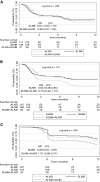Time to deterioration in quality of life score as a modality of longitudinal analysis in patients with breast cancer
- PMID: 21948650
- PMCID: PMC3228064
- DOI: 10.1634/theoncologist.2011-0085
Time to deterioration in quality of life score as a modality of longitudinal analysis in patients with breast cancer
Abstract
Purpose: This prospective multicenter study explored different definitions of time to deterioration (TTD) in quality of life (QoL) scores, according to different cutoffs of the minimal clinically important difference (MCID) as a modality for longitudinal QoL assessment in breast cancer patients.
Methods: QoL was assessed using the European Organization for Research and Treatment of Cancer Quality of Life Questionnaire C30 and BR-23 before surgery, after surgery, and 6 and 12 months later. The global health score, arm symptoms score (BRAS), and breast symptoms score were analyzed. For a given baseline score, QoL was considered to have deteriorated if this score decreased by ≥5 points at any time point after baseline. Analyses were repeated using an MCID of 10 points and taking the score after surgery as the reference score (to explore the occurrence of response shift). TTD was calculated using the Kaplan-Meier method and Cox regression was used to identify independent factors associated with TTD.
Results: Two hundred thirty-five patients underwent axillary lymph node dissection (ALND), 222 underwent sentinel lymph node biopsy (SLNB), and 61 underwent SLNB plus ALND. Patients who underwent SLNB had a significantly longer TTD for the BRAS dimension than those who underwent ALND. Cox multivariate analyses showed that treatment using SLNB and age >59 years were independently associated with longer TTD for the BRAS, whereas surgery elsewhere than at the Centre Georges François Leclerc was associated with a shorter TTD.
Conclusion: Exploration of different definitions of TTD in QoL provides meaningful longitudinal QoL results for clinicians.
Conflict of interest statement
The content of this article has been reviewed by independent peer reviewers to ensure that it is balanced, objective, and free from commercial bias. No financial relationships relevant to the content of this article have been disclosed by the authors or independent peer reviewers.
Figures


Similar articles
-
A multicenter cohort study to compare quality of life in breast cancer patients according to sentinel lymph node biopsy or axillary lymph node dissection.Ann Oncol. 2009 Aug;20(8):1352-61. doi: 10.1093/annonc/mdp016. Epub 2009 May 25. Ann Oncol. 2009. PMID: 19468032 Clinical Trial.
-
Impact of sentinel node biopsy on long-term quality of life in breast cancer patients.Br J Cancer. 2013 Nov 26;109(11):2783-91. doi: 10.1038/bjc.2013.658. Epub 2013 Oct 29. Br J Cancer. 2013. PMID: 24169352 Free PMC article. Clinical Trial.
-
Quality-of-life impact of sentinel lymph node biopsy versus axillary lymph node dissection in breast cancer patients.Value Health. 2012 Sep-Oct;15(6):907-15. doi: 10.1016/j.jval.2012.06.003. Value Health. 2012. PMID: 22999141
-
Quality of life after sentinel lymph node biopsy or axillary lymph node dissection in stage I/II breast cancer patients: a prospective longitudinal study.Ann Surg Oncol. 2008 Sep;15(9):2533-41. doi: 10.1245/s10434-008-9996-9. Epub 2008 Jul 3. Ann Surg Oncol. 2008. PMID: 18597146 Free PMC article.
-
Sentinel lymph node biopsy after previous axillary surgery: A review.Eur J Surg Oncol. 2012 Jan;38(1):8-15. doi: 10.1016/j.ejso.2011.10.003. Epub 2011 Oct 26. Eur J Surg Oncol. 2012. PMID: 22032909 Review.
Cited by
-
Comparison of three longitudinal analysis models for the health-related quality of life in oncology: a simulation study.Health Qual Life Outcomes. 2014 Dec 31;12:192. doi: 10.1186/s12955-014-0192-2. Health Qual Life Outcomes. 2014. PMID: 25551580 Free PMC article.
-
Patient-reported outcomes for the Intergroup Sentinel Mamma study (INSEMA): A randomised trial with persistent impact of axillary surgery on arm and breast symptoms in patients with early breast cancer.EClinicalMedicine. 2022 Nov 25;55:101756. doi: 10.1016/j.eclinm.2022.101756. eCollection 2023 Jan. EClinicalMedicine. 2022. PMID: 36457648 Free PMC article.
-
An explorative study to assess the association between health-related quality of life and the recommended phase II dose in a phase I trial: idarubicin-loaded beads for chemoembolisation of hepatocellular carcinoma.BMJ Open. 2016 Jun 24;6(6):e010696. doi: 10.1136/bmjopen-2015-010696. BMJ Open. 2016. PMID: 27342239 Free PMC article. Clinical Trial.
-
Transarterial Radioembolization Versus Atezolizumab-Bevacizumab in Unresectable Hepatocellular Carcinoma: A Matching-Adjusted Indirect Comparison of Time to Deterioration in Quality of Life.Adv Ther. 2022 May;39(5):2035-2051. doi: 10.1007/s12325-022-02099-0. Epub 2022 Mar 12. Adv Ther. 2022. PMID: 35279814 Free PMC article.
-
Health-related quality of life in adults with relapsed/refractory acute lymphoblastic leukemia treated with blinatumomab.Blood. 2018 Jun 28;131(26):2906-2914. doi: 10.1182/blood-2017-09-804658. Epub 2018 May 8. Blood. 2018. PMID: 29739753 Free PMC article. Clinical Trial.
References
-
- Staquet M, Berzon R, Osoba D, et al. Guidelines for reporting results of quality of life assessments in clinical trials. Qual Life Res. 1996;5:496–502. - PubMed
-
- Osoba D, Zee B. Completion rates in health-related quality-of-life assessment: Approach of the National Cancer Institute of Canada Clinical Trials Group. Stat Med. 1998;17:603–612. - PubMed
-
- Osoba D, Rodrigues G, Myles J, et al. Interpreting the significance of changes in health-related quality-of-life scores. J Clin Oncol. 1998;16:139–144. - PubMed
Publication types
MeSH terms
LinkOut - more resources
Full Text Sources
Medical
Research Materials

